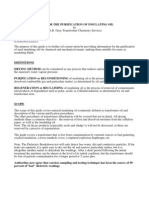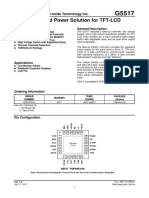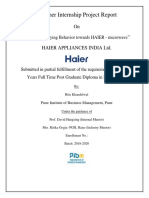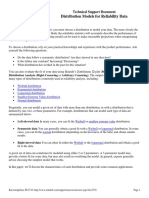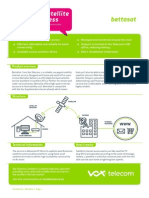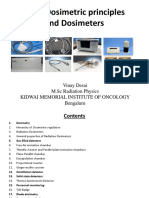Purification of Transformer Oil in Pt. PJB Up Paiton: January 2016
Purification of Transformer Oil in Pt. PJB Up Paiton: January 2016
Uploaded by
Hoang NguyenCopyright:
Available Formats
Purification of Transformer Oil in Pt. PJB Up Paiton: January 2016
Purification of Transformer Oil in Pt. PJB Up Paiton: January 2016
Uploaded by
Hoang NguyenOriginal Title
Copyright
Available Formats
Share this document
Did you find this document useful?
Is this content inappropriate?
Copyright:
Available Formats
Purification of Transformer Oil in Pt. PJB Up Paiton: January 2016
Purification of Transformer Oil in Pt. PJB Up Paiton: January 2016
Uploaded by
Hoang NguyenCopyright:
Available Formats
See discussions, stats, and author profiles for this publication at: https://www.researchgate.
net/publication/309404071
PURIFICATION OF TRANSFORMER OIL in PT. PJB UP PAITON
Article · January 2016
DOI: 10.5281/zenodo.56908
CITATIONS READS
0 1,279
1 author:
Totok R. Biyanto
Institut Teknologi Sepuluh Nopember
131 PUBLICATIONS 135 CITATIONS
SEE PROFILE
Some of the authors of this publication are also working on these related projects:
Optimization of Car Engine Performance Using Duelist - Killer Whale - Rain Water Optimizations Algorithms View project
Retrofit Heat Exchanger Network in Refinery and Power Plant View project
All content following this page was uploaded by Totok R. Biyanto on 20 February 2017.
The user has requested enhancement of the downloaded file.
[Wahdaniyah* et al., 5(7): July, 2016] ISSN: 2277-9655
IC™ Value: 3.00 Impact Factor: 4.116
IJESRT
INTERNATIONAL JOURNAL OF ENGINEERING SCIENCES & RESEARCH
TECHNOLOGY
PURIFICATION OF TRANSFORMER OIL in PT. PJB UP PAITON
Gusti Wahdaniyah*, Purnomo Tri Prasetyo, Arif Setiabudi, Totok R. Biyanto
PT. PJB UP Paiton, Probolinggo, Indonesia
Department of Engineering Physics, Institut Teknologi Sepuluh Nopember (ITS) Surabaya, Indonesia
DOI:
ABSTRACT
The purpose of this paper is to describe the filtration or purification of transformer oil. One of the main equipment in
coal-fired power generation unit is transformer. When the transformer fail to operate properly, the continuity of
distribution system become interrupted. As a part of transformer, transformer oil contribute the failure of transformer
due to the aging. To solve this problem, several methods is applied starting from dehydration process, degasification
process, oxidation removal and filtration or purification. After the purification process is performed, the transformer
oil then analyzed. The result shows that the purified transformer oil is better than before purified.
KEYWORDS: Transformer oil, purification, failure.
INTRODUCTION
Transformer is the main equipment in coal-fired power generation unit (PLTU) aside from the turbine equipment, cold
handling and boiler. In the condition of normal load plant capacity, age of the transformer depends on the used
insulation where the insulation has a mechanical, electrical resistance and protected oil isolation that will make the
transformer has the ability to work accepting load or high electrical pressure (electric stress) [1]. Transformer oil as
liquid insulation operates to separate the parts that have difference voltage between parts so that do not occur leap
electrical (flash-over) or spark (spark-over). The failure of the insulation on the high-voltage equipment that occurs
when equipment is operating, it could cause damage to the tool so that the continuity of distribution system becomes
interrupted. From the few cases show that isolation failure related to the existence of a partial discharge. Partial
discharges can occur in solid insulating materials, liquid insulating materials and gas insulating materials. The failure
mechanism on solid insulating material covers intrinsic failures, electro mechanical, thermal and erosion. On gas
material is mainly caused by the mechanism of town send and the mechanism of steamer. While in the liquid material
is caused by bubbles (cavitation), and mixed liquid insulation material (contamination). Liquid insulation is used
because it has 1000 times more density than gas insulation and has high dielectric strength, liquid insulation will fill
a gap or space that will be isolated, and it can absorb the heating that arises and insulates the liquid that tend to be able
to repair itself if there is a release of charge (discharge). But the main drawback of liquid insulation is easily
contaminated [2]. The Damage of the oil insulation in transformer is more caused by age, where naturally insulating
paper that used will damage continuously and naturally transformer oil also oxidize continuously, because there is
oxygen in the oil or there is air in the transformer. Reclamation, inhibitor giving and its product bond such as acid or
sludge and return the oil to the new conditions. The speed of this oxidizing product strongly affected the conditions
of temperature, moisture, electric stress, quality of paper insulation transformer. Nowadays, advanced measurement
and forecasting of these variables [3-4]. There are also several research already available in assessing the health of
transformer oil [5-7]. Meanwhile, in this paper purification process is conducted to assess and restore the transformer
oil health.
REVIEW
Water in Tranformer Oil
Water in transformer oil is obtained from the atmosphere or the product of a chemical reaction. In oil insulation, water
can occur in some of the following conditions:
http: // www.ijesrt.com © International Journal of Engineering Sciences & Research Technology
[91]
[Wahdaniyah* et al., 5(7): July, 2016] ISSN: 2277-9655
IC™ Value: 3.00 Impact Factor: 4.116
In dissolved condition
In emulsion condition
In the bottom container transformer
Even very little amount of water can have significant effects to transformer characteristics. In this case, the presence
of water emulsion is more dangerous than dissolved condition. Figure 1 shows the curve relationship between the
dielectric strength and quantity of water emulsion in mineral insulator oil.
The water quantity that can dissolve in the oil is directly proportional to the increase in the oil temperature as described
in the curve of Figure 2. Then the oil temperature should be considered for separation of water from oil, because the
purification oil in high temperature can decrease the dielectric strength, when water transformation is dissolved to be
emulsion.
Paper isolation on transformer is very porous and it can absorb water in great abundance. The increasing amount of
dissolved water and emulsion in oil insulating, then the amount of absorbed water on the paper insulation is getting
bigger as well. As a result is greatly able to decrease the dielectric strength. After being absorbed, the water is very
difficult to be eliminated. Therefore, to prevent the absorption, it is necessary to keep the water content in oil insulation
at certain level as low as possible [2].
Basic Test for Determining of Tranformer Oil State
Sub-subheading should be 10pt Times new roman, Italic, Justified.
The degradation process of the oil insulation can be monitored and measured by a series of tests, the most important
and widely applied is as following:
1. Water content – test ASTM D 1533
Water is one of the factors that affect the oil quality and transformer characteristic in the transformer. Water content
should be at a level that is as low as possible (no more than 30 ppm) [2].
2. Dielectric strength – test ASTM D 877, D 1816
Characteristic from dielectric strength on transformer oil is very important and usually it will be investigated
first. Physically, dielectric strength is the voltage at which the transformer oil that starts to work. The value should be
at the highest level. The decrease of this value indicates the increase of water content in transformer oil [2].
3. Neutral number - acidity number – test ASTM D 974
The unit of acidity number is mgKOH/mg that represents caustic potassium milligram that added to the gram of oil to
neutralize the acidity. The oil transformer in new condition almost no acid level if the storage procedure and
transformer charging is done correctly. The value of new oil acidity is below 0.05. Acidity level increases in line with
the oxidation process in the oil and proportional to the amount of oxygen content in the oil. Acidity limit in the
transformer oil is 0,2, because in the value of acidity to reach 0,4 resinoid layer will form drastically that affects
characteristic transformer [2].
4. Inter surface stress – IFT test – test ASTM D 971
Inter surface stress is a characteristic that allows the formation of resinoid layer, although it does not mean that this
layer is formed. Physically, inter surface stress is the force that required to break down the oil layer, which is on the
boundary between oil and water. Unit is N/m (or mN/m). The value for the new oil is around 40 mN/m. The value of
inter surface good stress is more than 22 mN/m. Transformer Oil which has inter surface stress with a value of between
15 and 22 mN/m should be purified, while under 15 mN/m it almost certainly shows a resinoid layer [2].
In addition to the fourth above tests also contain several tests for oil isolator such as specific gravity, colour, total
dissolved combustable gas, visual/sediment, total furan, liquid power factor, inhibitor content, and corrosive sulfur
METHOD
Because of the importance of the use of the transformer on a regular basis, reviewing the complexity degradation and
the aging to the problem of the isolation transformer, at this point some methods have been developed, especially
concerning the improvement of condition of isolation transformer passes through some of the following procedures:
1. Dehydration (Removing water content )
2. Degasification (Removing oxygen content and another gases)
3. Removing several oxidation process.
4. Filtration.
Filtration that the most commonly used is in the following:
Natural sedimentation
http: // www.ijesrt.com © International Journal of Engineering Sciences & Research Technology
[92]
[Wahdaniyah* et al., 5(7): July, 2016] ISSN: 2277-9655
IC™ Value: 3.00 Impact Factor: 4.116
Natural sediment is based separation of water at the bottom of the transformer container naturally, while the
transformer does not operate for at least 24 hours. After that, the oil is pumped out while the water content removed
from the bottom, cleaning is performed repeatedly until the natural sediment is removed. This method is rather slow
and requires more energy, and the efficiency is less satisfactory to meet the standard set [2]
Filter presses
Filter presses can consist of several types of construction but the most used type is based on the principle of circulation
of oil through a series of filtering and absorbing (e.g. filter paper). This method cannot be used to oil degasification. To
remove water content, filtering element must be replaced and dried periodically [2].
Portable devices with filter elements
Portable devices for filtering elements are frequently used because of their small size, easy handling and several
advantages that are compared to use another larger filter. In these devices, there are several ready-used elements such
as cartridge that is used to filter the oil from 1 µm to 25 µm. This device can separate the water and the oil very well[2].
Coalescer filtration
Filtration coalescer is a comparatively new developed method, based on filtering methods for aircraft fuel. The
filtering element is made of fiberglass where water can be separated because of the increase of differential pressure
on its operational. This method has the advantage over the other methods, but the main drawback is the sensitivity of
the filtering elements to the solid particles in the oil.
Vacuum dehydration
Vacuum dehydration method is widely used and highly efficient which oil purification was done by warming the oil
isolator and drying it in a vacuum. In this condition boiling point of water is significantly low and the separation of
the water content of the oil can be applied. This method is very efficient to use degasification. The main drawback of
the method is the energy needs for heating oil during the process of purification. An increase in temperature of the
insulating oil is above 65°C, then drying it in a vacuum has caused the loss of an important oil fraction required for
good insulation quality of oil [2]. While at a lower temperature, drying efficiency will decrease rapidly. Transformer
oil purification in PT PJB Paiton also uses this vacuum dehydration method.
RESULTS AND DISCUSSION
After Purification, transformer oil becomes in good condition again as shown in Table 1.
Table 1. The Results of Laboratory Test of Transformer Oil
Reference The Value
Variable Unit
Standard Standard Before After
Neutralisir Number (ACID) MgKOH/mg ASTM D974 <0.06 0.014 0.014
Interfacial Strenght (IFT) mN/m ASTM D971 >32 34.9 37.2
Dielectric Strenght (DIEL) kV ASTM D877 >=30 90 91
0.84-
Specific Gravity (SP. GR) ASTM D1298 0.8718 0.8784
0.91
Colour ASTM D1524 <=3.5 1.5 1.5
Total Dissolved Combustable Gas ASTM D3612 720 53 1
Visual/Seiment ASTM D1524 Clear Clear Clear
Total Furan ASTM D5837 <100 ND ND
20oC <0.1 0.060 0.010
Liquid Power Factor ASTM D924
100oC <2.99 2.140 2.990
Inhibitor Content ASTM D2688 >0.20 ND 0.34
Water Content (Moisture) ppm ASTM D1533 <30 7 6
Corrosive Sulfur ASTM D1275B 1 1B 1B
From the table above shows that the water content in oil transformer declined from 7 ppm to 6 ppm and acquiesce on
standard range that are used i.e. < 30 ppm. For dielectric strength and interfacial strength increases gradually with the
value of 91 kV and 23.1 mN/m. Then for neutralizer number does not changed significantly after purification i.e.
0.014 MgKOH/mg, but it is still on standard range that is used.
http: // www.ijesrt.com © International Journal of Engineering Sciences & Research Technology
[93]
[Wahdaniyah* et al., 5(7): July, 2016] ISSN: 2277-9655
IC™ Value: 3.00 Impact Factor: 4.116
CONCLUSION
From the results of testing on the lab showed oil transformer parameters before and after reclaimed according the
standard range that is given. Acid level increased from the standard condition 0.008 mmKOH/mg to 0.014
mmKOH/mg. Interfacial tension, specific gravity, and inhibitor content increase after purification. Interfacial tension
increased from 34.9 mN/m to 37.2 mN/m, specific gravity increased from 0.8781 into 0.8784 and inhibitor content of
ND is 0.34. For the value of moisture and dissolved gases decreases after purification is 7 ppm to 6 ppm for moisture
and 53 ppm to 1 ppm for dissolved gas.
ACKNOWLEDGEMENTS
The authors gratefully thank to PT. PJB UP Paiton Indonesia for providing the facilities in conducting this research.
REFERENCES
[1] J. Filippini, R. Tobazéon, P. Guuinic, and O. Moreau, "The spontaneous ionic purification phenomenon of
transformer oil: Presentation and consequences," Journal of Electrostatics, vol. 67, pp. 737-740, 2009.
[2] I. Mačužić and B. Jeremić, "Modern Approach to Problems of Transformer Oil Purification," Tribology in
industry, Kragujevac, vol. 24, 2002.
[3] Bin, Song, and Li En-Wen. "Study on state of health for power transformer oil with multiple
parameters." Power System Technology (POWERCON), 2014 International Conference on. IEEE, 2014.
[4] Malik, Hasmat, et al. "UV/VIS response based fuzzy logic for health assessment of transformer oil." Procedia
Engineering 30 (2012): 905-912.
[5] NEGARA, Yulistya, et al. Investigation of intrinsic breakdown of transformer oil insulation: An experimental
approach. In: Power Engineering and Renewable Energy (ICPERE), 2014 International Conference on.
IEEE, 2014. p. 66-69.
[6] DU, Y., et al. Measurements of moisture solubility for differently conditioned transformer oils. In: Dielectric
Liquids, 1999.(ICDL'99) Proceedings of the 1999 IEEE 13th International Conference on. IEEE, 1999. p.
357-360.
[7] FEI, Sheng-wei, et al. Particle swarm optimization-based support vector machine for forecasting dissolved
gases content in power transformer oil.Energy Conversion and Management, 2009, 50.6: 1604-1609.
http: // www.ijesrt.com © International Journal of Engineering Sciences & Research Technology
[94]
View publication stats
You might also like
- Operation Manual: Inverter Air-Conditioner DetectorDocument17 pagesOperation Manual: Inverter Air-Conditioner DetectorLUIS FERNANDO PINONo ratings yet
- CallRecord LogDocument59 pagesCallRecord LogArunava Basu RayNo ratings yet
- Chemistry 121 The University of British Columbia Midterm Examination II November 13, 2013Document12 pagesChemistry 121 The University of British Columbia Midterm Examination II November 13, 2013emily_voong19No ratings yet
- Purification of Transformer Oil in Pt. PJB Up Paiton: January 2016Document5 pagesPurification of Transformer Oil in Pt. PJB Up Paiton: January 2016Venkataramanan SNo ratings yet
- Advancementinoil Filtrationwith Electrostatic Oil CleanerDocument17 pagesAdvancementinoil Filtrationwith Electrostatic Oil CleanerKrithvin Ajay & Krithisha AdvikaNo ratings yet
- Transformer OilDocument14 pagesTransformer OilGeorgina SuleNo ratings yet
- Transformer Oil Analysis For Maintenance ProgramsDocument10 pagesTransformer Oil Analysis For Maintenance Programskechaouahmed81No ratings yet
- IV WORKSPOT - Maintenance-free Dehydrating Breathers for Transformers and OLTCsDocument14 pagesIV WORKSPOT - Maintenance-free Dehydrating Breathers for Transformers and OLTCsEtolcachirNo ratings yet
- Insulating Oil Regeneration and ItsDocument8 pagesInsulating Oil Regeneration and Itsmarlom machado do nascimentoNo ratings yet
- Pongamia Pinnata As Alternate Liquid Dielectrics in Distribution Transformer: A Critical Study On The Property of ViscosityDocument8 pagesPongamia Pinnata As Alternate Liquid Dielectrics in Distribution Transformer: A Critical Study On The Property of ViscosityMadavan RNo ratings yet
- p123 Icste2018Document6 pagesp123 Icste2018benlahnecheNo ratings yet
- Transformer Oil Maintenance: 1 Montgomery Road, Mount Edgecombe, 4300, South Africa Bskinner@illovo - Co.zaDocument7 pagesTransformer Oil Maintenance: 1 Montgomery Road, Mount Edgecombe, 4300, South Africa Bskinner@illovo - Co.zahadrienNo ratings yet
- Oil Diagnostics Data Sheet TransformersDocument2 pagesOil Diagnostics Data Sheet TransformersAmlanshankar Deb BarmaNo ratings yet
- Performance Analysis of Fuel Oil Purifier Filtration Process On Ships Mv. Tanto LuasDocument5 pagesPerformance Analysis of Fuel Oil Purifier Filtration Process On Ships Mv. Tanto Luasgilar herliana putraNo ratings yet
- Preventive and Corrective Maintenance For Transformers in OperationDocument6 pagesPreventive and Corrective Maintenance For Transformers in OperationbenlahnecheNo ratings yet
- Progres FYP Sunflower OilDocument29 pagesProgres FYP Sunflower OilMizs LiezaNo ratings yet
- Aged Oils Reclamation: Facts and Arguments Based On Laboratory StudiesDocument11 pagesAged Oils Reclamation: Facts and Arguments Based On Laboratory StudiesnirookasraNo ratings yet
- Transformer Oil - Wikipedia PDFDocument19 pagesTransformer Oil - Wikipedia PDFAkash SahaNo ratings yet
- Failure Analysis of A Power Transformer Using Dissolved Gas Analysis - A Case StudyDocument4 pagesFailure Analysis of A Power Transformer Using Dissolved Gas Analysis - A Case StudyesatjournalsNo ratings yet
- MEE Micro ProjectDocument15 pagesMEE Micro ProjectSanchit BamaneNo ratings yet
- Transformer OilDocument4 pagesTransformer OilJohnParkerNo ratings yet
- Injection of Nitrogen Foam For Improved Oil Recovery in Viscous Oil Reservoirs Offshore Bohai Bay ChinaDocument14 pagesInjection of Nitrogen Foam For Improved Oil Recovery in Viscous Oil Reservoirs Offshore Bohai Bay ChinaRoberticoZeaNo ratings yet
- Transformer Oil - WikipediaDocument22 pagesTransformer Oil - WikipediaGian CoderisNo ratings yet
- Breakdown of OilsDocument14 pagesBreakdown of OilsPathum Sudasinghe50% (2)
- O-Engineers Jan 2018Document39 pagesO-Engineers Jan 2018Enpak ArsalanNo ratings yet
- Icpea 2019 8818492Document5 pagesIcpea 2019 8818492Andi Yusuf MasalanNo ratings yet
- 2005-LTC Diagnostics PDFDocument21 pages2005-LTC Diagnostics PDFfahrian05No ratings yet
- Effect of Insulating Oil Level On DissipDocument8 pagesEffect of Insulating Oil Level On DissipJerry Mar LucenaNo ratings yet
- Transformer Health Monitoring SystemDocument10 pagesTransformer Health Monitoring SystemPavan Kumar A GNo ratings yet
- Iptc 14952 MsDocument19 pagesIptc 14952 MsAryan GoyalNo ratings yet
- 1.1.0 Background 1.1.1 Chemical ReactorsDocument5 pages1.1.0 Background 1.1.1 Chemical ReactorsEvan ChinNo ratings yet
- Assessing_insulating_oil_degradation_by_means_of_turbidity_and_UV_VIS_spectrophotometry_measurementsDocument8 pagesAssessing_insulating_oil_degradation_by_means_of_turbidity_and_UV_VIS_spectrophotometry_measurementsUmair AslamNo ratings yet
- JETIRES06095Document6 pagesJETIRES06095karthickeyan250No ratings yet
- Transformer OilDocument8 pagesTransformer OilAbdul HameedNo ratings yet
- Vgs Trafo Dry OutDocument8 pagesVgs Trafo Dry OutvikashNo ratings yet
- Condition Monitoring of TransformerDocument26 pagesCondition Monitoring of TransformerHenrich PordanNo ratings yet
- Proof Reading 23-01-2019Document16 pagesProof Reading 23-01-2019oumertleilaNo ratings yet
- 40 Article 22 1 10 20200419Document5 pages40 Article 22 1 10 20200419liai linNo ratings yet
- Transformer Oil: ExplanationDocument8 pagesTransformer Oil: ExplanationshaikamirulhasanNo ratings yet
- DGA Differences Between Natural Esters and MineralDocument8 pagesDGA Differences Between Natural Esters and MineralMohd Taufiq IshakNo ratings yet
- On-Line Reclamation of Aged: Transformer OilsDocument9 pagesOn-Line Reclamation of Aged: Transformer OilsBaharin HashimNo ratings yet
- Guide of Transformer Oil TestingDocument5 pagesGuide of Transformer Oil Testingoorja.sachinborkarNo ratings yet
- Performance Analysis of Nanofluid Based Lubricant: I J I R S E TDocument7 pagesPerformance Analysis of Nanofluid Based Lubricant: I J I R S E TSreejith SNo ratings yet
- Power Transformer Condition Monitoring and Assessment ForDocument6 pagesPower Transformer Condition Monitoring and Assessment ForsureshnfclNo ratings yet
- Solomon Compiled WorkDocument50 pagesSolomon Compiled WorkockiyacliffcNo ratings yet
- Paper PublishedDocument6 pagesPaper PublishedTarun ChowdaryNo ratings yet
- Hermetically Sealed Vs Dry TypeDocument5 pagesHermetically Sealed Vs Dry TypeqxzyNo ratings yet
- Power Transformer Condition Monitoring and Remanent Life AssessmentDocument5 pagesPower Transformer Condition Monitoring and Remanent Life AssessmentAmarinder DhimanNo ratings yet
- Maintainces (Mee)Document19 pagesMaintainces (Mee)vishal mahajanNo ratings yet
- 2011performance and Emission Charateristics of A Diesel Engine Fueled by Rapeseed Oil Bio-FuelDocument9 pages2011performance and Emission Charateristics of A Diesel Engine Fueled by Rapeseed Oil Bio-FuelchikeluNo ratings yet
- MEE Unit 5Document21 pagesMEE Unit 5dipak1980No ratings yet
- GraCE 2016 Proceeding Imran Sutan ChairulDocument5 pagesGraCE 2016 Proceeding Imran Sutan ChairulSharin Ab GhaniNo ratings yet
- A Study On Palm Oil-Based Oil Moisture Absorption Level and Voltage Breakdown PDFDocument4 pagesA Study On Palm Oil-Based Oil Moisture Absorption Level and Voltage Breakdown PDFvvingtsabtaNo ratings yet
- Testing of TransformerDocument24 pagesTesting of TransformerObakoma JosiahNo ratings yet
- Real Time Monitoring of A Distribution TDocument9 pagesReal Time Monitoring of A Distribution TAli Hussain Ali MahmoudNo ratings yet
- Transformer Oil PurificationDocument7 pagesTransformer Oil PurificationAther AliNo ratings yet
- DesigningVacuumtower (VDU)Document26 pagesDesigningVacuumtower (VDU)Bilal KhanNo ratings yet
- Transformer Oil Analysis: Water ContentDocument12 pagesTransformer Oil Analysis: Water ContentSanjeev DhariwalNo ratings yet
- Guidelines For Rla of Transformers PDFDocument9 pagesGuidelines For Rla of Transformers PDFMohammad AsifNo ratings yet
- Naval Diesel Engineering: The Fundamentals of Operation, Performance and EfficiencyFrom EverandNaval Diesel Engineering: The Fundamentals of Operation, Performance and EfficiencyNo ratings yet
- Gas-Engines and Producer-Gas Plants A Practice Treatise Setting Forth the Principles of Gas-Engines and Producer Design, the Selection and Installation of an Engine, Conditions of Perfect Operation, Producer-Gas Engines and Their Possibilities, the Care of Gas-Engines and Producer-Gas Plants, with a Chapter on Volatile Hydrocarbon and Oil EnginesFrom EverandGas-Engines and Producer-Gas Plants A Practice Treatise Setting Forth the Principles of Gas-Engines and Producer Design, the Selection and Installation of an Engine, Conditions of Perfect Operation, Producer-Gas Engines and Their Possibilities, the Care of Gas-Engines and Producer-Gas Plants, with a Chapter on Volatile Hydrocarbon and Oil EnginesNo ratings yet
- Machinery Oil Analysis & Condition Monitoring : A Practical Guide to Sampling and Analyzing Oil to Improve Equipment ReliabilityFrom EverandMachinery Oil Analysis & Condition Monitoring : A Practical Guide to Sampling and Analyzing Oil to Improve Equipment ReliabilityRating: 3.5 out of 5 stars3.5/5 (5)
- STS WiFi (MAR2011v2)Document27 pagesSTS WiFi (MAR2011v2)Hoang NguyenNo ratings yet
- Bridge Monitoring SystemsDocument43 pagesBridge Monitoring SystemsHoang NguyenNo ratings yet
- Interest Rates, R&D Investment and The Distortionary Effects of R&D IncentivesDocument43 pagesInterest Rates, R&D Investment and The Distortionary Effects of R&D IncentivesHoang NguyenNo ratings yet
- Long Run Behavior of R&D Investment and Economic Growth: A Macro-Econometric ModelDocument35 pagesLong Run Behavior of R&D Investment and Economic Growth: A Macro-Econometric ModelHoang NguyenNo ratings yet
- Multi 0 PageDocument30 pagesMulti 0 PageHoang NguyenNo ratings yet
- Civil EngineeringTrans PDFDocument80 pagesCivil EngineeringTrans PDFHoang NguyenNo ratings yet
- Explaining The Broken Link Between R&D and GDP Growth: Preliminary: Do Not Cite Without PermissionDocument19 pagesExplaining The Broken Link Between R&D and GDP Growth: Preliminary: Do Not Cite Without PermissionHoang NguyenNo ratings yet
- Technical References: System ElementsDocument4 pagesTechnical References: System ElementsHoang NguyenNo ratings yet
- Integrated Power Solution For TFT-LCD: Global Mixed-Mode Technology IncDocument1 pageIntegrated Power Solution For TFT-LCD: Global Mixed-Mode Technology IncVeicon VecNo ratings yet
- Apple Iphone Common Problems and Their Solutions 2019Document5 pagesApple Iphone Common Problems and Their Solutions 2019nCik Sukasuki100% (1)
- Period, Frequency, Wavelength, and Wave Speed Practice WorksheetDocument1 pagePeriod, Frequency, Wavelength, and Wave Speed Practice WorksheetDd Simpkins100% (1)
- AtomDocument12 pagesAtomJason MendozaNo ratings yet
- Miniature Mercury OCXO Application NotesDocument8 pagesMiniature Mercury OCXO Application NotesullascsNo ratings yet
- Magnetic Work Light RecargableDocument1 pageMagnetic Work Light RecargableAlicia AltamiranoNo ratings yet
- Location Fingerprinting of Mobile Terminals by Using Wi-Fi DeviceDocument4 pagesLocation Fingerprinting of Mobile Terminals by Using Wi-Fi DeviceIjarcet JournalNo ratings yet
- Shalaka Potdar CV MumbaiDocument2 pagesShalaka Potdar CV Mumbaiapi-3800762No ratings yet
- Mt8870 DTMF DecoderDocument17 pagesMt8870 DTMF DecoderLawrence NgariNo ratings yet
- Air Mouse Remote ManualDocument5 pagesAir Mouse Remote ManualAmin BurghulNo ratings yet
- Nderpreres I Fuqise-ABBDocument60 pagesNderpreres I Fuqise-ABBkusha02No ratings yet
- HaierDocument36 pagesHaierRitu KhandelwalNo ratings yet
- AIX - From New User To Technical ExpertDocument372 pagesAIX - From New User To Technical Expertapi-3730815No ratings yet
- Reliability DistributionDocument16 pagesReliability DistributionJavier Alejandro Rodriguez MelgozaNo ratings yet
- 056-090 73xx MKI To 73xx MKII ConversionDocument2 pages056-090 73xx MKI To 73xx MKII ConversionBJNE01No ratings yet
- Inductive: Tubular SensorDocument15 pagesInductive: Tubular Sensorandleralfonso7308No ratings yet
- Klingon ProgrammersDocument1 pageKlingon ProgrammerskgrhoadsNo ratings yet
- Betta Sat CatalogueDocument2 pagesBetta Sat CatalogueCorey AcevedoNo ratings yet
- TCB501HQ Datasheet en 20160628Document29 pagesTCB501HQ Datasheet en 20160628Lorenzo Torres100% (1)
- High Power Prison Jammer Large Shielding Raduis For PrisonDocument2 pagesHigh Power Prison Jammer Large Shielding Raduis For PrisonJammerworldNo ratings yet
- Wind Tunnel LabDocument8 pagesWind Tunnel LabVashik BedasieNo ratings yet
- Tenma 72 8155LCRDocument26 pagesTenma 72 8155LCRbaggeroliNo ratings yet
- 13-Transistor Transceiver For Digital Kit Assembly Manual: DraftDocument28 pages13-Transistor Transceiver For Digital Kit Assembly Manual: Draftfox7878No ratings yet
- Basic Dosimetric PrincipleDocument73 pagesBasic Dosimetric Principleradiologi rsud solokNo ratings yet
- SCC800-S1 SmartSite Management System V100R003C00 Installation GuideDocument192 pagesSCC800-S1 SmartSite Management System V100R003C00 Installation GuideHamza Osama100% (1)
- Ethernet Radio Module Technical Speci IcationsDocument2 pagesEthernet Radio Module Technical Speci IcationsHamat AfinNo ratings yet
- Simply The Best: Model OSJ 146/440 Open Stub J-PoleDocument6 pagesSimply The Best: Model OSJ 146/440 Open Stub J-PolejaiherdNo ratings yet























































